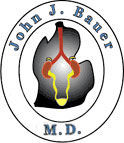
www.flinturology.com
Urology Services, Inc.
G-1121 West Hill Rd.
Flint, Michigan 48507
Tel: 810.232.8888
Fax: 810.232.9190
Email: jbauer@flinturology.com
[map]
 |
John J. Bauer, M.D.
www.flinturology.com Urology Services, Inc.
|
Vasectomy Reversal
John J. Bauer, MD, Urologist
Vasectomies have been done since the turn of the century and the first recorded reversal was done about 1936. Over the years, more and more vasectomies have been performed and more reversals. With the advent of the operative microscope, the success rate of reversals has improved considerably. Prior to about 1970, without the use of the microscope, the number of pregnancies resulting from reversal of a vasectomy was about 19% and sperm returned to the ejaculate about 33% of the time. Since 1970, without the use of the microscope, the number of pregnancies resulting from reversal of a vasectomy has been about 38% and sperm return to the ejaculate about 65-70% of the time. With the use of the microscope, the pregnancy rate is about 50-70% and sperm returns to the ejaculate about 80-90% of the time, depending on the length of time between the vasectomy and the reversal.
The vas deferens, which is the tube that carries sperm from the testicle (where it is produced and which was cut at the time of the vasectomy), is about 2.5 mm (1/10 inch) in diameter. The lumen or hole in the center of he vas is about 0.5 mm (1/50 inch) in diameter and it is this portion, which must be realigned for proper passage of sperm. Because of this tiny structure, magnification with the microscope allows better visualization and, thus, a better chance of aligning the lumen. The suture used is about 1/2 to 1/3 the size of a human hair.
The procedure is generally done as an outpatient under general anesthesia. Although the procedure is not much more painful than the vasectomy, if takes a considerably longer time to do and the patient is not able to hold still for that period of time without his back hurting, his nose itching, is arm aching, and the like. Even the slightest movement by the patient that occurs while looking under the microscope is like an earthquake and interferes with the delicate surgery at hand. Thus, patients are usually put asleep, not for pain, but to hold them absolutely still.
Postoperatively, the pain is usually no more than the original vasectomy, requiring mild pain medication, ice packs, and rest for a couple of days. The only restriction after the operation is to avoid excessive jumping, running, and the like for fear of tearing the delicate sutures which are used in the surgery, until the body has had sufficient time to repair the site and heal it back to its normal strength. This is about two months. As with any surgery, the success of this surgery is not 100%, but failed reversals can be redone.
Occasionally, because of the vasectomy and back-pressure on the epididymis, blowouts and obstruction in the epididymis do occur. The success rate in this small group is not as good and may necessitate repair of or bypass of the blowout.
More information about vasectomy reversal >>